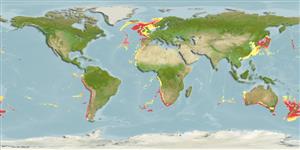| Native range | All suitable habitat | Point map | Year 2100 |

|
| Deania calcea AquaMaps Data sources: GBIF OBIS |
Length at first maturity
Lm 105.0, range 70 - 111 cm
Human uses
Fisheries: minor commercial
Phylogenetic diversity index
(Ref. 82805)
PD50 = 0.5625 many relatives (e.g. carps) 0.5 - 2.0 few relatives (e.g. lungfishes)
Trophic Level
(Ref. 69278)
4.3 ±0.4 se; Based on diet studies.
Resilience
(Ref. 69278)
Very Low, minimum population doubling time more than 14 years (K=0.077-0.135; Fec=6-12; tm=25)